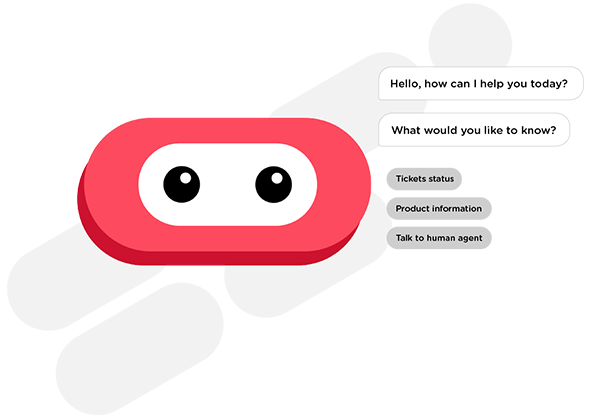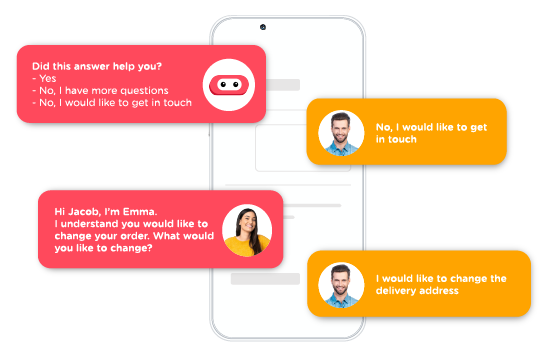- 1. Have a solid strategy in place
- 2. Fuel your chatbot with data
- 3. Personalize conversations
- 4. Taking chatbot to Live Chat
- 5. Learn and innovate
- Offer personalized service
Build a genuinely effective chatbot? That's not an easy thing to do. Although the technology may be easy, you have to think about the concept carefully. There is nothing more frustrating than a bot that fails to help you. For example, by not understanding you, or giving incomplete or irrelevant answers. These five tips will guide you on your way to building a bot that truly helps your customers.
1. Have a solid strategy in place
Are there plans for a chatbot? A good starting point is the "why" question. Why do you want to start using a chatbot? What is the goal? Consider whether a chatbot is the right means to achieve your goals.
Forrester's research shows many companies are deploying bot technology for the wrong reasons. These include companies wanting to go along with the hype, expecting fewer contact moments, or wanting to replace service staff with a bot. Not only does this fail to have a positive effect on the bot's performance, it also jeopardizes the customer experience. Therefore, make a good business case. Don't focus on one KPI, such as cost savings, but consider all aspects of customer contact.
Think forward, but start small. A chatbot is often part of a larger transformation. Based on the phase you are in as a company, decide how and what to automate. Start in a smart way, scale up when possible. For example, start with a chatbot on your website and later expand it to different channels.
2. Fuel your chatbot with data
The "why" question is naturally followed by the "what" question. What can customers do with your chatbot? What can they do with the bot? Or what questions can it answer?
To perform, a chatbot requires input. The easiest variant is a Scripted Chatbot. You set up a flow yourself, which the customer follows. It's really a closed dialogue. The bot offers choices based on preset rules and the customer's input. Advanced bots offer more possibilities. You construct full open dialogues, which you can optimize based on performance with the help of AI technology. The AI bot not only learns from your input, but also from customer queries. Integrate the technology with your ERP, CRM or contact center systems and databases to create a personalized experience. As a first step, you can enter the 100 most frequently asked questions and answers, or connect the bot to your customer data.
An advanced AI bot, with sufficient data and the necessary functionalities, can do much more than just answer routine questions. A customer is genuinely being helped within the conversation. AI prevents the question from not being recognized, avoiding incomplete or irrelevant answers. Recognizing the customer, verification, handling transactions, and executing tasks: a competent chatbot can do it all. Think about a status update of your package, or delaying your payment.
Make it clear to your customer what your bot can and cannot do, to prevent disappointment.

3. Personalize conversations
But don't get too personal. For many people using messaging channels is still something they do with friends and family. You do want to talk in a similar way, but not too friendly. Choose the right tone of voice, appropriate for your company. Let the conversations flow naturally. Use brief, understandable sentences. When a customer contacts you, the most important thing is that he or she is helped well, in a way that is convenient for them. Straightforward language helps.
As a customer, you don't want to have to provide too much information. If you've given your name and email address, you expect the rest of your data to be known as well. To handle personal matters, more data may be needed. Make sure the chatbot can access the data and recognize and authenticate the customer. By integrating your systems, for example with your Customer Data Platform, your chatbot can access the full customer profile. This way, it knows more than just the name.
Speaking of names, do you already have a name for your chatbot? This gives your bot an identity, making it more personal.
4. Taking chatbot to Live Chat
Sometimes a bot can't help you. Or you simply don't want to talk to a chatbot. Ensure an easy and quick hand-over to or take-over by an employee. Ask if your customer is being helped well, or wants to be re-routed. For both the employee and the customer it is beneficial if the employee can see the conversation. With the right customer service tooling, you have insight into every conversation, and into the complete customer profile. This way you know exactly how you can assist the customer even better.
Never compromise on the quality of customer contact. Give your customer multiple options to contact you. A bot is convenient, but for several urgent, emotional, or complex service questions, human input is sometimes necessary. Chatbots are also used to reach out to a customer service representative. If a customer asks the bot about contact options, provide them with a full list of possibilities. Consider the phone number, but be transparent about when and how you can best be reached. Do you only deploy your bot outside of business hours? Then tell your customers when they can speak to an employee.
Combining bot and personal support from your service team will make your service even better. Not only for your customer but also for your company.

5. Learn and innovate
A chatbot can always be improved. Review and analyze conversations to learn from them. Where does a customer get stuck? Is the bot giving the right answer in all cases? With the right insights, you can improve your conversations. Implement good reporting options. AI technologies present opportunities for improvement based on customer input.
Dare to innovate. Think about the next step, to prepare for the future. How can customers reach you at the moment? Would a bot work via WhatsApp? Or perhaps as a voicebot, when customers call? Ask your customers for feedback. How would they like to interact with Conversational solutions? You learn from feedback.
Keep testing, keep learning.
Offer personalized service
Automate in a safe and considered approach. Your chatbot can't do it alone. Human input and support are still needed to provide good service. By being transparent about what your customers can and cannot do with your bot, you avoid frustration. Continue to provide personalized, good service - whether via a bot or via your service team.
Want to know more about intelligent chatbots that can genuinely help your customers? Contact us or read more about Conversational AI.
